ISSN ONLINE(2319-8753)PRINT(2347-6710)
ISSN ONLINE(2319-8753)PRINT(2347-6710)
AnfasMukram T1, Suneesh P U2
|
| Related article at Pubmed, Scholar Google |
Visit for more related articles at International Journal of Innovative Research in Science, Engineering and Technology
The thesis discusses the performance analysis of an active solar desalination system with boosting mirrors. The variables used in this work are solar intensity, glass cover inlet temperature, glass cover outlet temperature, basin temperature. Numerous literatures and experimental results are available in active and passive solar desalination. The fresh water output is increased considerably by using an active solar desalination system. In this work active and passive desalination systems with and without booster mirror are compared. Here an active solar desalination system with air pump is used. The performance of the active and passive solar stills with and without boosting mirror is studied and their efficiency is also compared. The experiment is carried out during the summer climatic conditions of Kerala.
Keywords |
| Solar energy, Active solar distillation, Air pump, boosting mirrors |
INTRODUCTION |
| Water is a gift of nature and it plays a key role in the development of an economy and in turn for the welfare of a nation. Non-availability of drinking water is one of the major problem faced by both the under developed and developing countries all over the world. Around 97% of the water in the world is in the ocean, approximately 2% of the water in the world is at present stored as ice in polar region, and 1% is fresh water available for the need of the plants, animals and human life [1]. Today, majority of the health issues are owing to the non-availability of clean drinking water. In the recent decades, most parts of the world receive insufficient rainfall resulting in increase in the water salinity. The pollution of water resources is increasing drastically due to a number of factors including growth in the population, industrialization, urbanization, etc. These activities adversely affected the water quality in rural areas and agriculture. Globally, 200 million hours are spent each day, mostly by females, to collect water from distant, often from polluted sources. In the world, 3.575 million people die each year from water related diseases. The basic medical facilities never spotted numerous villages in the developing and under developed countries. Majority of the rural people are still unaware of the consequences of drinking untreated water. Desalination is the oldest technology used by people for water purification in the world [2]. Various technologies were invented for desalination from time to time and it has been accepted by people without knowing future environmental consequences. Major desalination techniques like vapour compression distillation, reverse osmosis and electrolysis used electricity as input energy. But in the recent years, most of the countries in the world have been significantly affected by energy crisis because of heavy dependency on conventional energy sources (coal power plants, fossil fuels, etc.), which has directly affected the environment and economic growth of these countries. The changing climate is one of the major challenges the entire world is facing today. Gradual rise in global average temperatures, increase in sea level and melting of glaciers and ice sheets have underlined the immediate need to address the issue. All these problems could be solved only through efficient and effective utilization of renewable energy resources such as solar, wind, biomass, tidal, and geothermal energy, etc. Solar energy is the one of the major renewable energy available in the earth surface. Around 3,850,000 EJ of solar energy available in the earth‘s surface annually. Solar energy is available in abundant in most of the rural areas and hence solar distillation is the best solution for rural areas and has many advantages of using freely available solar energy. It is a simple technology and more economical than the other available methods. A solar still operates similar to the natural hydrologic cycle of evaporation and condensation. The basin of the solar still is filled with impure water and the sun rays are passed through the glass cover to heat the water in the basin and the water gets evaporated. As the water inside the solar still evaporates, it leaves all contaminates and microbes in the basin. The purified water vapours condenses on the inner side of the glass, runs through the lower side of the still and then gets collected in a closed container. |
| Many solar distillation systems were developed over the years using the above principle for water purification in many parts of the world. In India, several researches are done in this field. This project work involves the experimental comparison of double slope inverted V single basin passive solar still with an active solar still of the same type, which uses an air pump to agitate the water in the basin and an external reflecting mirror is also provided . The experiments are carried out in the Kerala climatic conditions during the summer. In this work the performance and efficiency of active and passive solar stills with and without external boosting mirrors are compared. The project work also extends to thermal modeling of active solar distillation systems, scope for further research and recommendation. |
II. CLASSIFICATION OF DISTILLATION SYSTEMS |
| Solar stills are classified in a number of ways. As per one category of classification which is based on the expected life span and application, the solar stills are classified into "permanent" (e.g. glass covered), "semi-permanent" (e.g. plastic covered) and "expandable" (e.g. double tube and floating type) type solar stills. However, one of the most commonly used classifications is based on the novelty of their design, and has been used here also. Following this, the simple solar stills are organized as given below: |
| Single basin solar stills |
| Inclined solar stills |
| Multi-basin solar stills |
| Solar earth water stills |
| Plastic solar stills |
II.1. SINGLE BASIN SOLAR STILLS |
| The single basin solar still represents one of the earliest designs used for distillation of water using solar energy directly. Its main advantage lies in its easy construction and simplicity of operation and maintenance. Basically, it consists of an airtight assembly enclosed at the top by a cover which is transparent to solar radiation, but opaque to the long wavelength radiation. The assembly is partially filled with the saline or brackish water. The absorption of solar radiation by the basin liner and water causes evaporation of water. The air-vapour mixture therefore attains higher temperature and lower density at the water surface. It moves upwards by the convection currents established because of the density gradient so created. When air-vapour mixture comes in contact with the top cover which is at a lower temperature as compared to the water surface, it cools down to saturation resulting in the condensation of water. The condensed water trickles down the inner surface of the top cover and is collected as distilled water in the troughs provided along lower edges of the top cover. Several configurations have been developed for single basin solar stills using different designs of basic structure and materials of construction. Figure 1 shows a deep basin solar still, designed by Lof et al. (1961) and later installed in 1958 at the Solar Distillation Research Station at Daytona Beach, Florida, USA. |
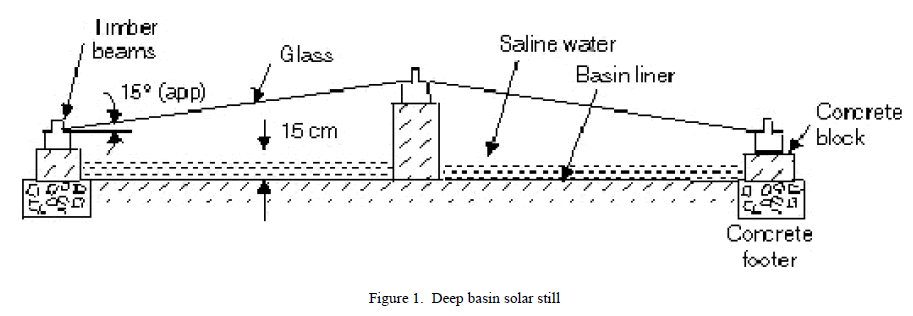 |
| Single basin solar stills are again classified according to the shape of the top transparent cover. They are |
| Single slope type |
| V type solar still |
| Inverted V type solar still |
| Hemispherical type solar still |
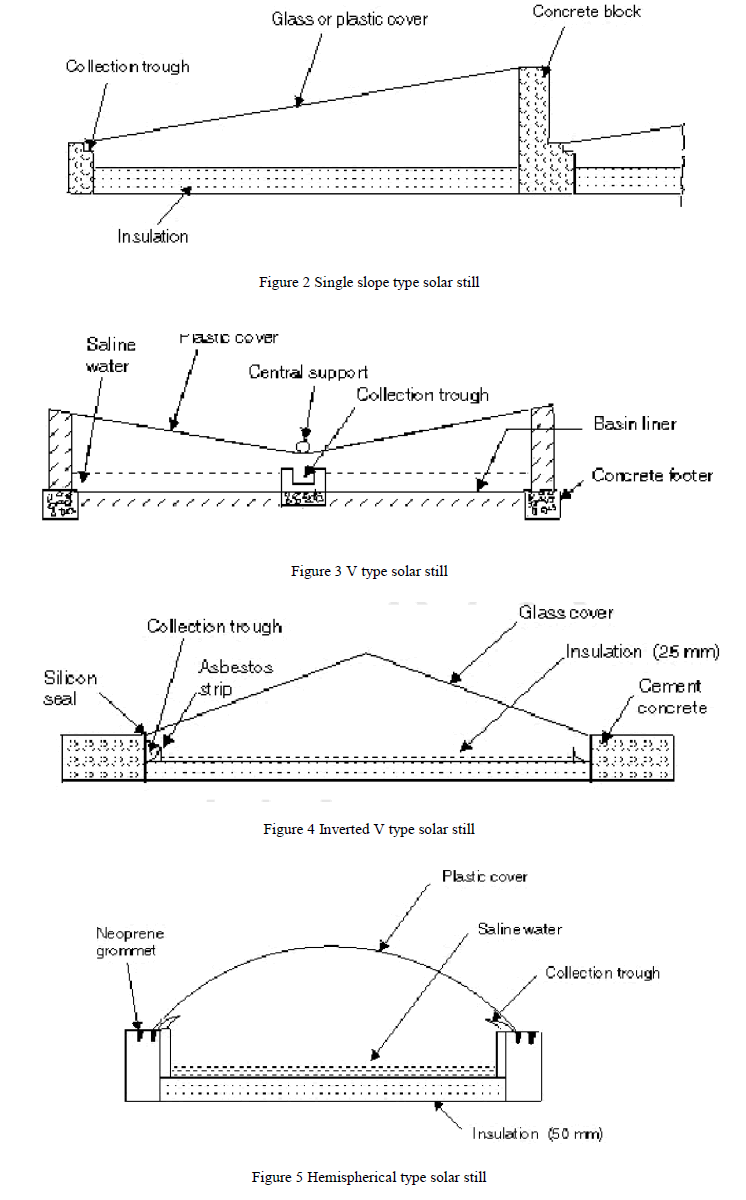 |
II.2 INCLINED SOLAR STILLS |
| As the name suggest the basin of this type of still is inclined at some angle to the horizontal. By making this type of stills, the distillate output is increased. Figure 7 shows the inclined solar still. |
II.3 MULTI-BASIN SOLAR STILLS |
| In this type of solar still, the basin is divided in to more than one chambers. Both chamber is filled with brackish water. |
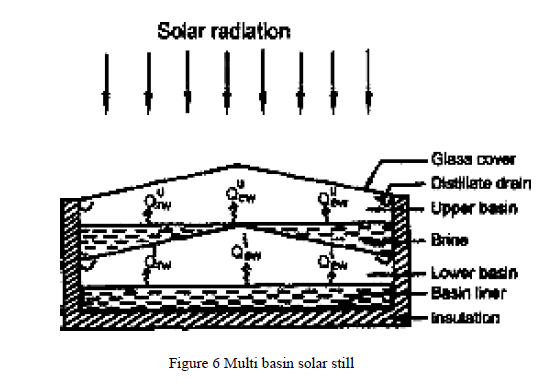 |
II.4 ACTIVE AND PASSIVE SOLAR STILLS |
| According to the type of input energy, the solar stills are classified into Passive and Active solar stills. In case of passive solar still, only solar energy is used for distillation purpose. In a passive solar still, the solar radiation is received directly by the basin water and is the only source ofenergy for raising the water temperature and consequently, the evaporation leading to a lower productivity. This is the main drawback of a passive solar still. Later, in order to overcome the above problem, many active solar stills have been developed. Here, an extra thermal energy is supplied to the basin through an external mode to increase the evaporation rate and in turn improve its productivity. The active solar distillation is mainly classified as follows [8]: |
| (i) High temperature distillation—Hot water will be fed into the basin from a solar collector panel. |
| (ii) Pre-heated water application—Hot water will be fed into the basin at a constant flow rate. |
| (iii) Nocturnal production—Hot water will be fed into the basin once in a day. |
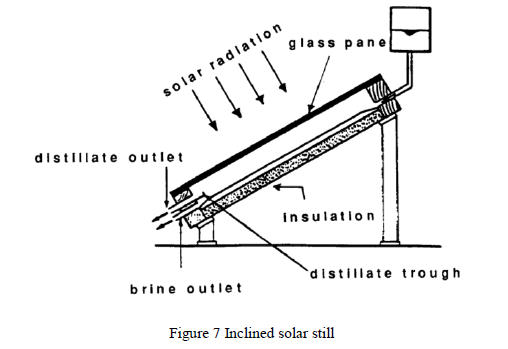 |
III. PARTS OF THE SOLAR STILL |
| The major parts of a solar still are given below. 1. Basin 2. Black Liner 3. Transparent Cover 4. Condensate Channel 5. Sealant 6. Insulation 7. Supply and Delivery System |
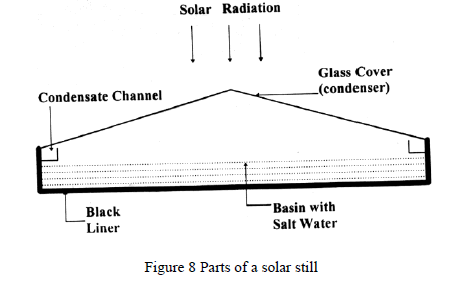 |
| III.1 Transparent Cover Transparent cover should have high transmittance for solar radiation, opaque to thermal radiation, resistance to abrasion, long life, low cost, high wet ability for water, lightweight, easy to handle and apply, and universal availability. This cover transfer solar radiation in to the still and also helps to condensate the vapour. The Materials used for transparent cover are glass or treated plastic. III.2 Liner A black liner is used in the basin of the solar still to absorb more solar radiation. The liner should be durable, water tight, easily cleanable, low cost, and should be able to withstand temperature around 1000C. The materials used for making liner are asphalt matt, black butyl rubber, black polyethylene etc. III.3 Sealant A sealant is used in the solar still to prevent the vapour leakages through the sides of the transparent cover. The sealant material should remain resilient at very low temperatures, low cost, durable and easily applicable. Materials used as sealant are putty, tars, tapes silicon etc. III.4 Basin Tray The salt/brackish water is initially stored in the basin tray of the solar still. The materials used for basins should have long life, high resistance to corrosion and low cost. The commonly used materials are wood, galvanized iron, steel, aluminium, asbestos cement, masonry bricks, concrete, etc. III.5 Condensate Channel The vapours generated inside the solar still is condensed on the inner surface of the transparent cover and the water droplets move downwards through the transparent cover. This fresh water is collected through the condensate channel fitted inside the solar still. The materials used for the condensate channel are Aluminium, galvanized iron, concrete, plastic materials, etc. III.6 Insulation The solar stills are thermally insulated to prevent the heat loss through the side walls and the basin. Vapour leakage is prevented by the sealant. All the energy received from the sun should be kept inside the still to vaporise water. The side walls and basin bottom are insulated by a low thermal conductivity material. The materials commonly used are saw dust, thermocole, glass wool etc. The better insulation will improve the performance of the still. III.7 Water Supply System Brackish or salt water should be supplied into the still continuously. In case of nocturnal production stills, water is fed once in a day [2][8]. In case of wick type systems, the feed rate of water should be kept equal to the evaporation rate of water from the still. Generally the water supply system includes an overhead tank, pipes to carry water into the still and regulatory valves. |
IV. EXPERIMENTATION |
| In this chapter we discuss different solar still models, which can be used for our analysis. Here we select a single basin type double slope inverted V type solar still for our experimental purpose. An external booster mirror is arranged for increasing the still output. The still can act as both passive and active type as per the setup. The governing equations are formulated and solved by selecting suitable assumptions. The results obtained by solving the equation are compared with the experimental value for active and passive solar stills with and without external booster mirror. For simplicity of the analysis we consider certain assumptions and our analysis are completely based on these assumptions and the results also confine to these assumptions. |
IV.1 Experimental Setup |
| Experimental setup consists of single basin type solar still with inverted V type roof made up of plain glass. The basin of the still is made by mild steel and the side walls are made by Galvanized Iron sheets and all the parts are painted black for better solar radiation absorption. The length and breadth of the solar still are 2.0 m and 1.0 m respectively. The side walls and the bottom of the still are well insulated by wood dust to minimize heat loss. An air pump is fitted and the outlet of which is connected to the holed pipe, which is fitted inside the basin. The top cover of the still is made by transparent glass with 3 mm thickness. A slope which is equivalent to that of the latitude (approximately 110) of the place is maintained for the roof. GI channels have been provided at the lower end of the glass cover tocollect the fresh water. Two reflecting mirrors of area 0.5 m2 each is fitted on separate stands to collect the solar radiation. The angles of the mirrors are adjusted during the experiment according to the position of the sun. |
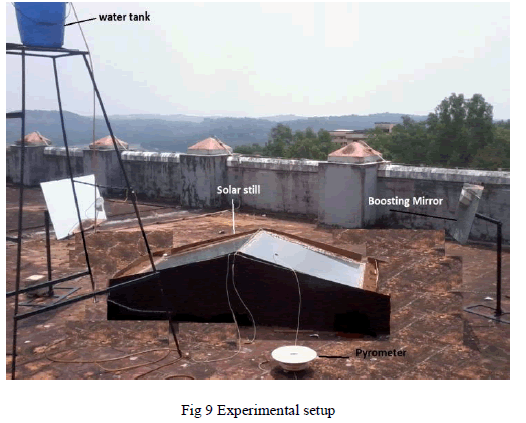 |
| The still is made active by fitting an air pump of 2.5 l/min capacity. The output of the pump is connected to the still through a pipe which is fitted at the bottom of the basin and immersed in water. At the basin, the pipe is perforated to produce air bubbles, which made the still active. The still can be used as both active and passive by selecting the air pump in on and off position. Water is supplied to the still from the tank, which is fitted on a stand near by the still. The basin of the still is filled with water at a height of 5 cm. Pyranometer is used to collect the total solar radiation received on a region per unit area. It has a bulb like receiver at the top. The output of the Pyranometer is measured by using a milli volt meter. Thermocouples of K Type are used to measure the temperature. Five thermocouples are fitted, one at the basin to measure the water temperature, one inside the still to measure the vapour temperature, one each at inside and outside the glass covers, and one thermocouple to measure the ambient temperature. The positions of thermocouples are shown in the Figure 10. |
IV.2 EXPERIMENTAL PROCEDURE |
| Initially the still is filled with water in the basin up to 5 cm height. Water and vapour leakages are checked and rectified initially. In the first experiment the still is worked as a passive still without external boosting mirrors. The still is positioned in such a way that the sloping sides always face the sun. Readings are taken at an interval of one hour till the sun drop in the evening. Record the solar intensity, five temperatures and still output in each interval. The output after the sun drop is collected in the morning. The above procedure is repeated in the next day with external reflecting mirrors and the readings are noted. Then the air pump is switched on and the still is active now. The above readings are noted for the active still with and without external boosting mirrors. |
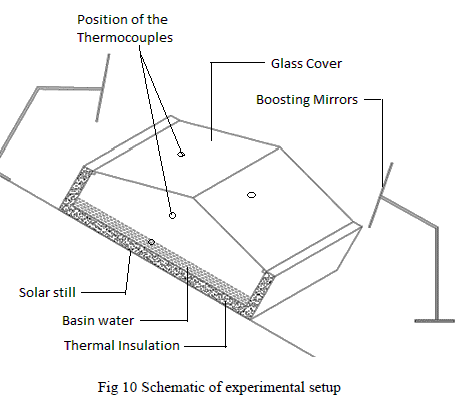 |
IV.3 ASSUMPTIONS |
| The following assumptions are considered while conducting experiments with the solar still. I. The solar still is vapour leakage proof. II. The level of water in the basin is maintained at a constant level. III. Inclination of glass cover is small. IV. No stratification of water occurs in the basin of the solar still. V. The heat capacity of the glass cover, absorbing and insulation materials (bottom and sides) is negligible. VI. The condensation that occurs through the glass is film type. VII. The thermal insulation is perfect, ie, no heat loss through the bottom and side walls of the still. These assumptions are valid throughout the analysis. |
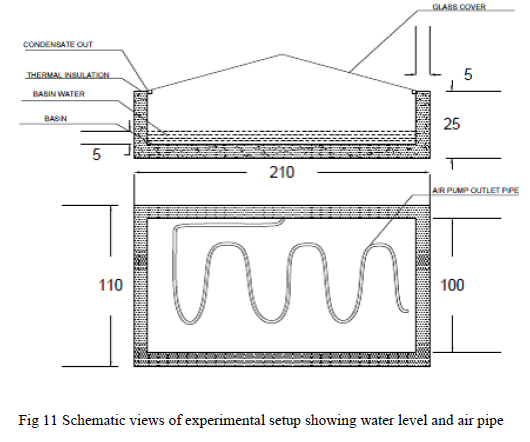 |
V. RESULTS AND DISCUSSIONS |
| The performance of still with boosting mirrors and air pump is analysed for the inverted ‗V‘ type solar still. The air pump increases the still output in case of active solar still. The air bubbles decreases the partial pressure of water and increasing the evaporation rate. The boosting mirror concentrates the incident radiation over the basin area and hence it causes the further increase of evaporation and water collection. |
| The figure 12 shows the variation of incident solar radiation received during the study as a function of time. The instantaneous solar radiation received was in the range of 37.5 – 1200 W/m2 and 62.5 – 1087.5 W/m2 for passive solar still without and with the boosting mirror. Similarly the solar radiation received was in the range of 62.5 – 1150 W/m2 and 37.5 – 1075 W/m2 for active solar still without and with the boosting mirror. The graph shows that the solar intensity increases with time and reaches a maximum at 12 30 pm in all days and then decreases. Around 6 30 pm the solar intensity reaches a minimum as the sun drops at that time. The Figure 13 shows the performance of active and passive solar stills with and without boosting mirrors. The distillate outputs of the stills during day time, night and total distillate outputs are compared. The figure shows that in case of active solar still with air pump, the distillate output is high due to the increasing evaporation rate. The boosting mirror (Case 4) concentrates the incident radiation over the basin area and hence it causes the further increase of evaporation and water collection. In case of passive solar stills (case 1 and 3) due to the boosting mirror the distillate output is increased. During night, the output remains same. |
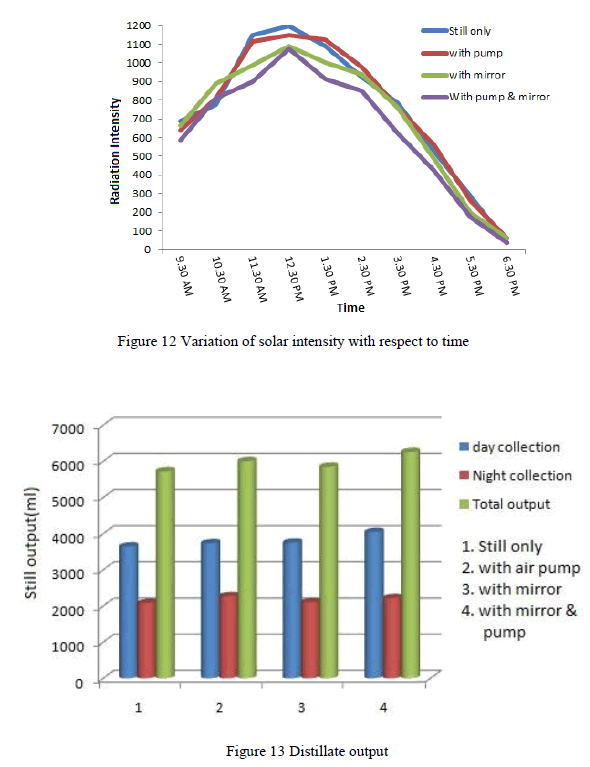 |
| The overall efficiency of the still is shown in Fig. 14. The overall efficiency was obtained as 21.4 % and 16.94 % for the passive still without and with the boosting mirror, and a similar experiment was carried out for the active still without and with the boosting mirror as 22.08 % and 13.11 % respectively. Though the yield was more, the efficiency was less for the still with the boosting mirror because the overall loss of this still was more due to the rise of the high temperature. |
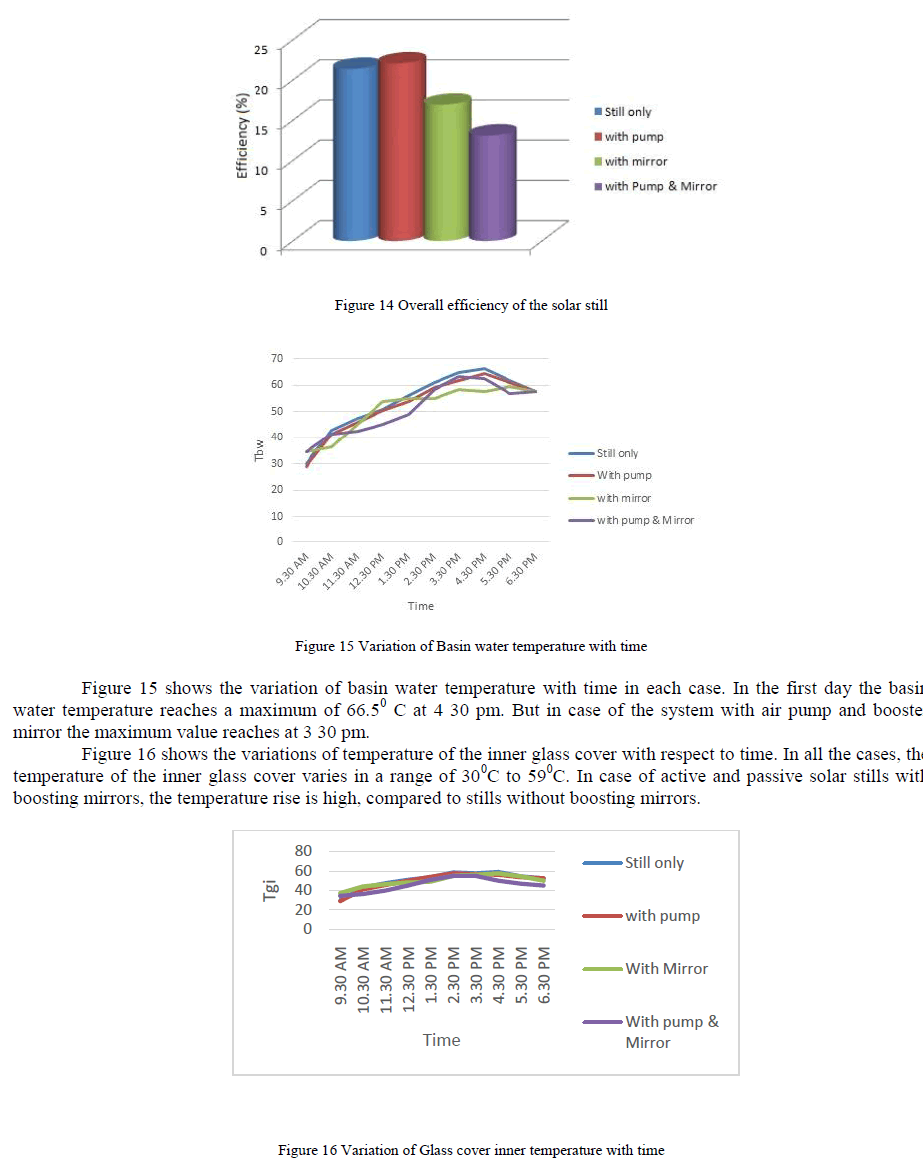 |
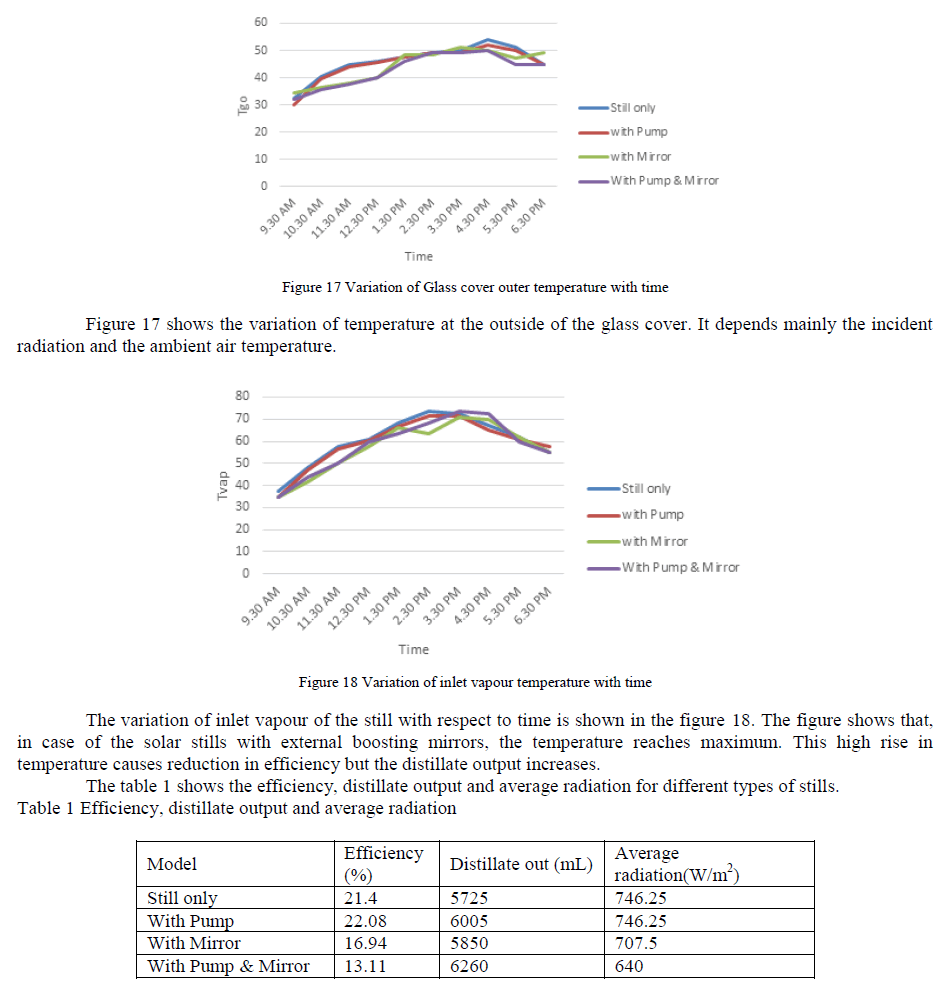 |
VI. CONCLUSIONS |
| The experimental analysis of the passive and active solar stills with and without boosting mirrors is done in the climatic conditions of Kerala in February. For the analysis same still is acted as active and passive by using an air pump. The performance of the active and passive stills are analysed and their efficiency is also calculated. The various temperatures like basin water temperature, inside and outside temperature of the glass cover and inside vapour temperature of the stills are recorded by using thermocouples and the data is plotted. The solar intensity shows similar variation during the days of the analysis. The periodic variation of the solar intensity for the days of analysis is also plotted. Their average value shows a similar variation in these days. The inside vapours temperature for the stills with boosting mirrors shows high value compared to the values without mirrors. This causes the reduction in efficiency for the stills with boosting mirrors. While comparing the stills by distillate output, maximum yield is obtained for the active still with boosting mirror. In case of active still, the air pump produces the air bubbles and which increases the evaporation rate and hence the distillate output is high. The distillate output during the night time is more for the active still. |
ACKNOWLEDGMENT |
| I would like to express my sincere gratitude to Prof. C P Muhammad, Head of the Department, Mechanical Engineering, M E S College of Engineering, Kuttippuram for his valuable guidance and wholehearted co-operation and continuous encouragement throughout this work. |
References |
|